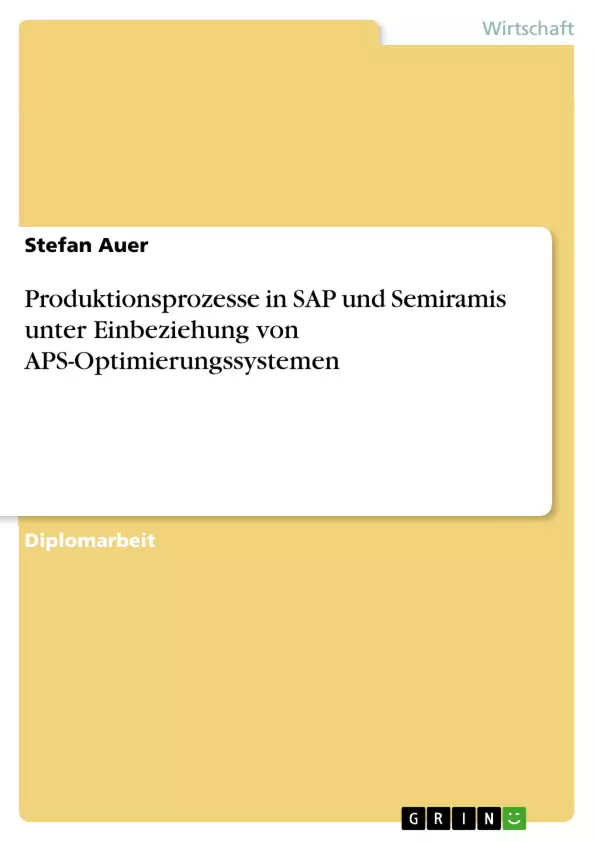Effizienz im Unternehmen ist eine Grundvoraussetzung, um in der heutigen Zeit am Markt bestehen zu können. Es gilt verstärkt, vielfach noch bestehende Ineffizienzen innerhalb der Unternehmensprozesse zu finden und diese zu beseitigen. Dies bewirkt einerseits deutliche Kostenreduktionen, andererseits werden dadurch aber auch die Prozesse im Unternehmen verkürzt und somit deutliche Zeitgewinne realisiert. Beides ist essentiell, um sich in Zeiten zunehmender Globalisierung gegen stärker werdende Konkurrenten im Wirtschaftsleben behaupten zu können.
So genannte ERP-Systeme helfen bei diesem so wichtigen Vorhaben, da sie eine gesamtheitliche Lösung für die Prozesse eines Unternehmens darstellen und verschiedenste Daten, beginnend von Personal- und Administrationsdaten über Finanzdaten bis hin zu Produktions- und Lagerdaten, an einem zentralen Ort speichern und verwalten können. Dies vermeidet Redundanzen, wie sie bei so genannten „Insellösungen“ (der Begriff bezeichnet in diesem Zusammenhang die Anwendung mehrerer voneinander getrennter Systeme für Personal, Finanzwesen, Produktion etc.) auftreten können, wo ein und die selben Daten oft mehrfach erfasst sind. Unterschiedliche ERP-Systeme bringen hierbei jeweils unterschiedliche Stärken und Schwächen mit sich.
Einen weiteren Schritt in Richtung Effizienzsteigerung im Unternehmen stellen so genannte APS-Systeme dar, welche als eine Erweiterung zu ERP-Lösungen bereits für eine Vielzahl von ERP-Systemen verfügbar sind. Aufbauend auf den Daten und Strukturen, wie sie im ERP System eines Unternehmens abgebildet sind, und unter Einhaltung aller unternehmensspezifischen Beschränkungen werden die im ERP-System erfassten Prozesse von Materialbeschaffung über Produktion bis zur Distribution weiter optimiert. [...]
Inhaltsverzeichnis
- Vorwort
- Inhaltsverzeichnis
- Abkürzungsverzeichnis
- Tabellenverzeichnis
- Abbildungsverzeichnis
- 1. Einleitung
- 1.1 Allgemeines
- 1.2 Einleitende Begriffsdefinition
- 1.3 Problemstellung
- 1.4 Zielsetzung
- 1.5 Aufbau der Arbeit
- 1.6 Vorgehensweise
- 2. Produktion
- 2.1 Einführung
- 2.2 Produktionsprozesse
- 2.3 Produktionsmerkmale
- 2.4 Ziele im Produktionsbereich
- 3. ERP-Systeme
- 3.1 Geschichtliche Entwicklung
- 3.2 Aufbau von ERP-Systemen
- 3.3 ERP-Komponenten
- 3.4 Merkmale von ERP-Systemen
- 3.5 Merkmale von ERP II-Systemen
- 3.6 Unterschiede ERP / ERP II
- 3.7 ERP-Marktübersicht
- 3.8 Einführung zu SAP
- 3.9 Einführung zu Semiramis
- 4. Produktionsplanung und -steuerung (PPS)
- 4.1 Einführung
- 4.2 Prozesse der Produktionsplanung und -steuerung
- 4.3 Ziele der Produktionsplanung und -steuerung
- 5. Produktionsprozess Rennrad „Auer“
- 5.1 Allgemeines zum Praxisteil
- 5.2 Eckdaten zum Prozess
- 5.3 Simulation in Excel
- 5.4 Abbildung in Semiramis
- 5.4.1 Anlegen des Lieferanten im System
- 5.4.2 Anlegen der Beschaffungsartikel
- 5.4.3 Anlegen des Produktionsartikels
- 5.4.4 Anlegen der Stückliste
- 5.4.5 Beschaffung der Komponenten vom Lieferanten
- 5.4.6 Anlegen der Ressourcen
- 5.4.7 Anlegen des Zeitmodells
- 5.4.8 Anlegen der Arbeitsgänge
- 5.4.9 Anlegen des Arbeitsplans
- 5.4.10 Definition des Produktionsplans
- 5.4.11 Erzeugen der Produktionsvorschläge
- 5.4.12 Erzeugung, Bearbeitung und Einlastung der Produktionsaufträge
- 5.4.13 Verbuchung der Produktionseingänge
- 5.4.14 Überprüfung des Lagerstandes
- 5.5 Abbildung in SAP
- 5.5.1 Anlegen des Lieferanten im System
- 5.5.2 Anlegen der Beschaffungsartikel
- 5.5.3 Anlegen des Produktionsartikels
- 5.5.4 Anlegen der Stückliste
- 5.5.5 Beschaffung der Komponenten vom Lieferanten
- 5.5.6 Anlegen der Ressourcen/Kapazitäten
- 5.5.7 Definition der Arbeitsplätze
- 5.5.8 Definition des Arbeitsplans
- 5.5.9 Erstellung der Planaufträge
- 5.5.10 Umsetzung der Planaufträge in Fertigungsaufträge
- 5.5.11 Buchung des Warenausgangs
- 5.5.12 Rückmeldung der Produktion
- 5.5.13 Buchung des Wareneingang zu den Fertigungsaufträgen
- 5.5.14 Überprüfung der Bestände des Produktionsartikels
- 5.6 Resümee zur Arbeit mit den Systemen
- 6. Bewertung der Systeme
- 6.1 Erlernbarkeit (20%)
- 6.2 Übersichtlichkeit/Präsentation (20%)
- 6.3 Bedienbarkeit (30%)
- 6.4 Umfang / Funktionalität (30%)
- 6.5 Zusammenfassende Bewertung
- 7. APS-Systeme
- 7.1 Übersicht
- 7.2 SAP APO
- 7.2.1 APO Überblick
- 7.2.2 Eigenschaften
- 7.2.3 Kosten-Nutzen-Analyse
- 8. Zusammenfassung
- Literaturverzeichnis
- Quote paper
- Stefan Auer (Author), 2007, Produktionsprozesse in SAP und Semiramis unter Einbeziehung von APS-Optimierungssystemen, Munich, GRIN Verlag, https://www.grin.com/document/71582




